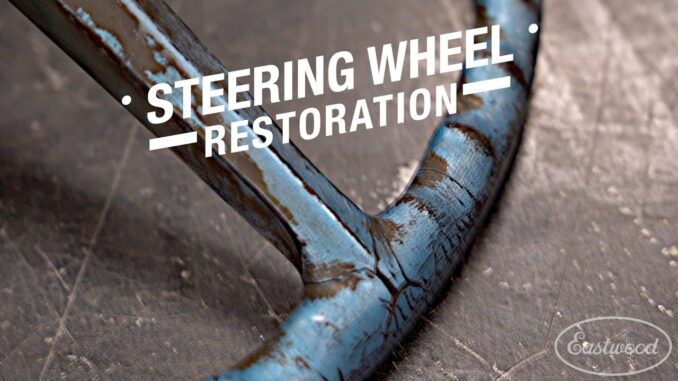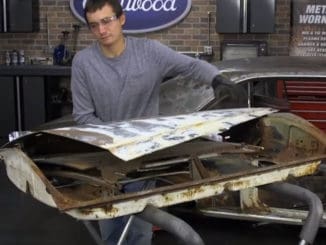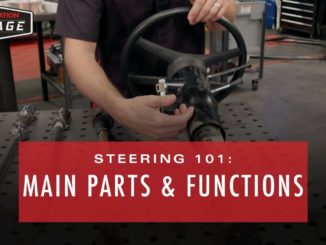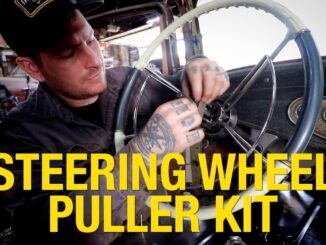
If you have a ragged old steering wheel and can’t find a replacement, you can refresh it instead with the right tools and supplies from Eastwood. Their money-saving Master Steering Wheel Repair Kit helps you restore your steering wheel to like-new condition, ready to top-coat.
In this video we repair an old C10 steering wheel using the Master Steering wheel repair kit from Eastwood.
Over time, UV light from the sun depletes the elastomers in your plastic or hard rubber steering wheels, resulting in ugly cracks that really date your car or truck.
Eastwood Master Steering Wheel Repair Kit
This master steering wheel restoration kit helps you bring those steering wheels back to life.
- PC-7 Epoxy
- Adhesion Promoter
- PRE Painting Prep
- Instructions and Restoration Book
The special ingredient of our rubber steering wheel repair kit is a can of PC-7 epoxy that acts as a glue for everything from wheels to gas tanks. You’ll also receive aerosol cans of SEM adhesion promoter and Eastwood painting prep to fill old cracks and get the wheel ready for a fresh topcoat.
Repair Plastic and Hard Rubber Steering Wheels
The ravages of time and UV light conspire to deplete your steering wheel of its elastomers. The resulting cracks can be repaired with this money-saving kit.
Use this Master Steering Wheel Restoration Kit with 1-lb. of PC-7 Epoxy (52047), an aerosol can of PRE Painting Prep (10041Z), an aerosol can of Adhesion Promotor (52366Z), instructions, and a copy of the Steering Wheel Restoration Book (52017) to repair cracked wheels and ready them for the color topcoat.
The SEM Vinyl Dyes (52066z-52081Z) work great over this kit.
- 52047 1-lb. Can of PC-7 Epoxy
- 10041Z or 11949z PRE Painting Prep (standard or Low-VOC)
- 52366Z Adhesion Promoter
- 52017 Steering Wheel Restoration Book
- Instructions
More info: https://www.eastwood.com/master-steer…
Restoring A Cracked Steering Wheel with Eastwood’s Master Steering Wheel Repair Kit
Posted on Eastwood: June 10, 2020 By: MattM
You’ve spent countless hours on bodywork and paint, your car’s engine is spotless, and the interior looks perfect… well, except for that cracked steering wheel.
If you’re in this situation, you have several options: live with the cracked steering wheel, try to locate a good used steering wheel, purchase a reproduction or aftermarket steering wheel, or repair your existing steering wheel.
For many, locating a good used steering wheel is difficult, and reproduction steering wheels (if available) are pricey. This leaves you with the options of either living with a cracked steering wheel or repairing the existing steering wheel.
Repairing a cracked hard plastic or rubber steering wheel is a lot easier than you might think.
To get started, you’ll first need to remove the steering wheel, and clean it with dishwashing detergent and water. After you’ve washed it, spray with PRE Painting Prep to remove oily residue that may have come from your skin.
For any cracks, you will want to use a triangle file to “V” the crack.
Tip: a Dremel-style tool also works well. This will allow you to completely fill the crack with the PC-7 Epoxy.
Mix the PC-7 following the directions on the back of the can. Slightly overfill the crack with the PC-7.
Tip: wet your finger with water to smooth out the PC-7.
Allow the PC-7 to cure for 24 hours.
After the PC-7 has thoroughly cured, start smoothing it with 240-grit sandpaper, and finish with 320-grit sandpaper. Spray it again with PRE to clean the surface.
Be sure to not handle the steering wheel with your bare hands, as this may contaminate the surface with oils from your skin. You are now ready to apply a primer.
Use Gray Self-Etch Primer to apply several light coats to smooth the surface. Once it dries, you’re ready to apply your topcoat. The self-etching primer creates a great base for almost any topcoat finish (epoxies are not recommended).




